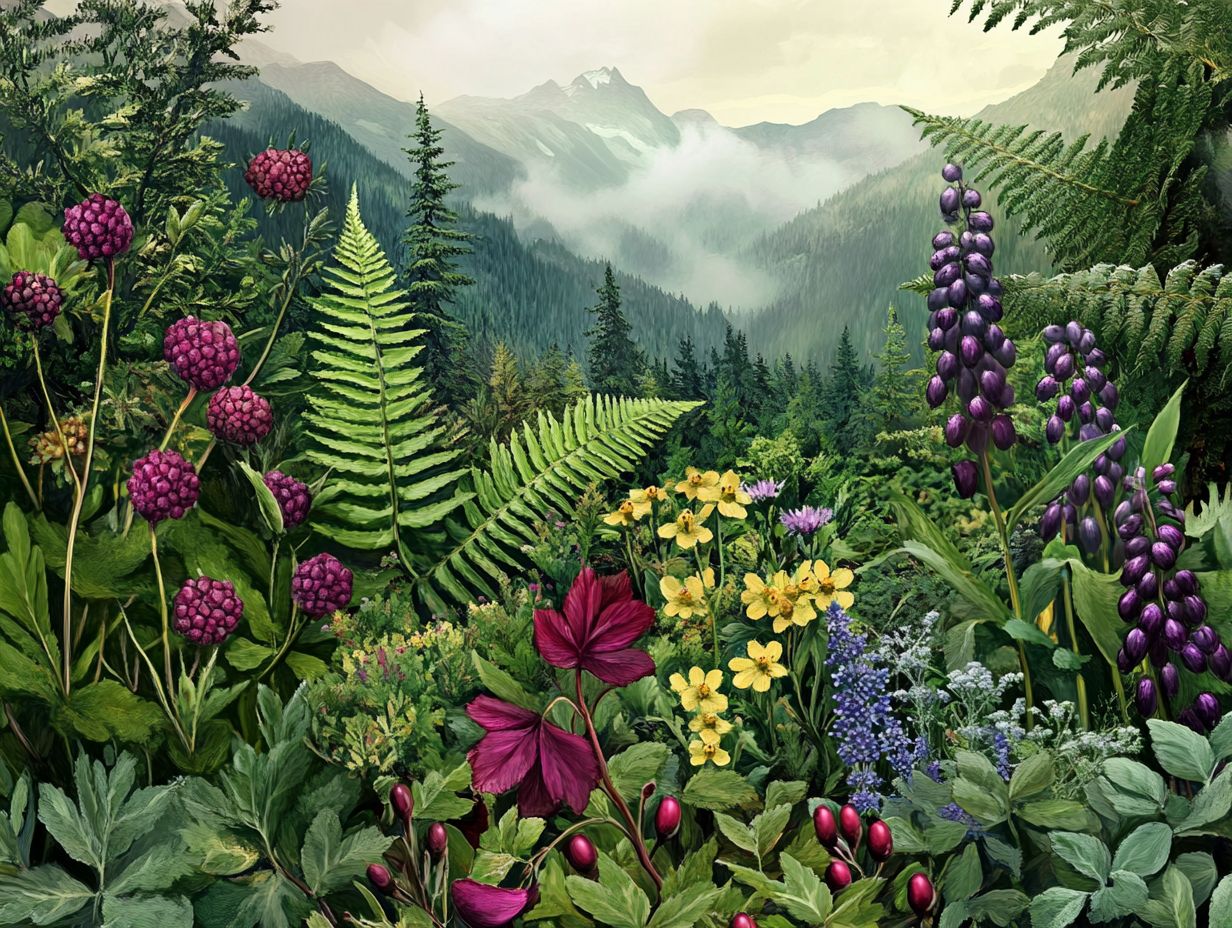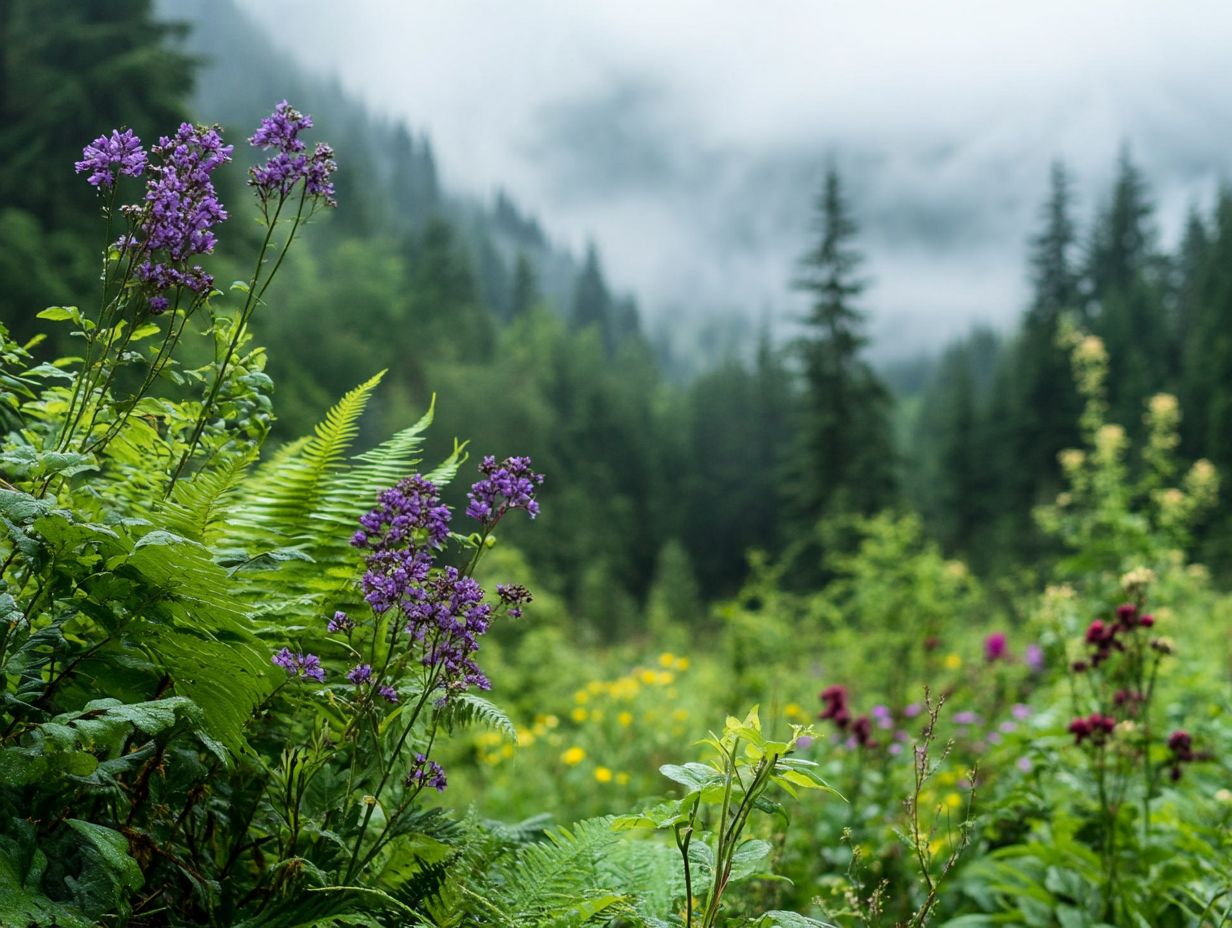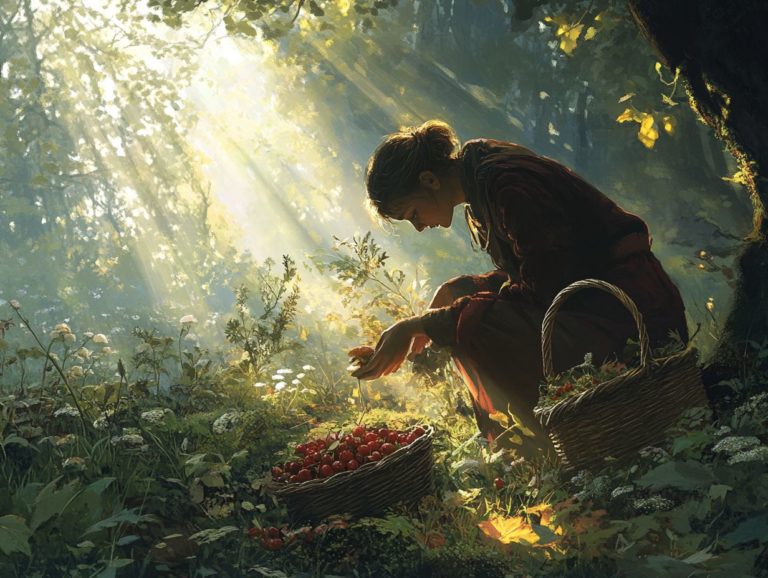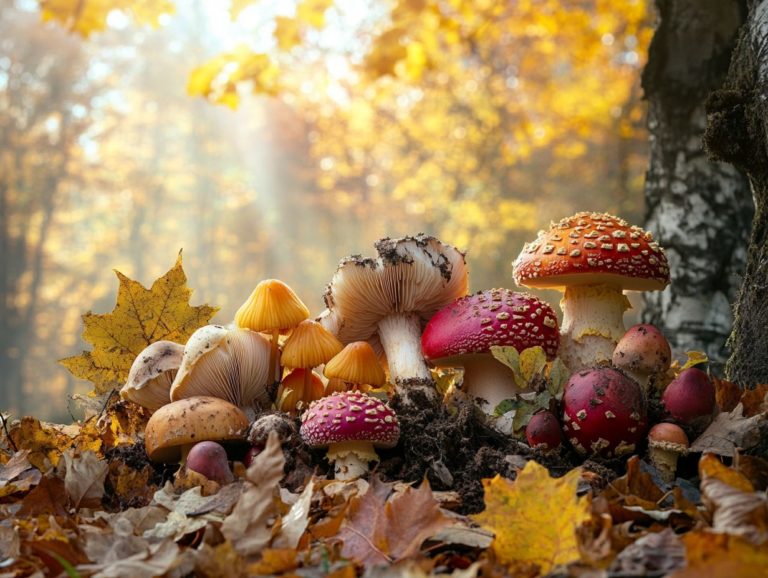Edible Plants of the Pacific Northwest
Foraging for edible plants isn t just a thrilling adventure; it s a journey that connects you to nature, your food sources, and sustainable living.
In the lush expanses of the Pacific Northwest, you ll find a treasure trove of wild edibles waiting to be discovered, from vibrant berries to nutrient-rich greens.
Get ready to dive into this guide! We will provide you with the knowledge to identify and harvest these plants, offer cooking tips that will elevate your dishes, and address important safety considerations for a secure foraging experience.
Embrace the art of foraging and learn how to protect these invaluable natural resources for generations to come.
Contents
- Key Takeaways:
- How to Identify and Harvest Edible Plants Safely
- Preparing and Cooking Edible Plants
- Safety Considerations
- Sustainable Foraging Practices
- Frequently Asked Questions
- What are some common edible plants found in the Pacific Northwest?
- Are there any poisonous plants in the Pacific Northwest that resemble edible plants?
- Can I forage for edible plants in the Pacific Northwest year-round?
- Do I need any special tools or equipment for foraging for edible plants in the Pacific Northwest?
- Can I find edible plants in urban areas of the Pacific Northwest?
- Are there any cultural or ethical considerations to keep in mind when foraging for edible plants in the Pacific Northwest?
Key Takeaways:

- Discover how foraging for edible plants in the Pacific Northwest can provide you with a unique and sustainable food source!
- Proper identification and harvesting techniques are crucial for safely incorporating wild edibles into your diet.
- Protecting and preserving edible plant populations is essential for sustainable foraging in the Pacific Northwest.
Why Forage for Edible Plants?
Foraging for edible plants offers an incredible opportunity to connect with nature while enhancing your cooking skills. In the Pacific Northwest, especially in areas like the North Cascades and Methow, you’ll find a vibrant diversity of edible plants, from spring wildflowers to stinging nettles, each offering unique culinary possibilities.
Foraging is not just a fulfilling activity; it also promotes your physical well-being, encouraging movement and exploration in natural settings.
Foraging offers more than just satisfying hunger; it brings enhanced nutritional value. Many wild plants are packed with vitamins and minerals that often outshine their cultivated counterparts. For example, stinging nettles are loaded with iron and antioxidants, adding a unique flavor profile to your dishes.
By immersing yourself in local ecosystems, you can build a deeper connection to the landscape, fostering respect for biodiversity.
Learning from experts like Hilary Dahl can transform your outing into an enriching educational journey, equipping you with skills to identify, harvest, and prepare these natural treasures, enhancing both your diet and your understanding of the environment, including the culinary uses of dandelions and mint.
How to Identify and Harvest Edible Plants Safely
Identifying and harvesting edible plants is a fundamental skill for any forager, especially in the vibrant biodiversity of the Pacific Northwest, where native edible plants flourish.
Take note of stinging nettle, salmonberry shoots, and false lily of the valley; each presents its own distinct flavors and impressive nutritional benefits, inviting you to explore the natural bounty around you.
Start your foraging adventure today!
Common Edible Plants in the Pacific Northwest
The Pacific Northwest is bursting with incredible edible plants. It s a true forager’s paradise just waiting for you to explore!
Consider stinging nettles, which can be used in many dishes, and the delicious salmonberry, a delightful treat. Don’t forget the unique flavors of Siberian miner’s lettuce, fiddlehead ferns, and camas, all ready to enhance your meals.
You can also add wild edibles like elderflower, with its fragrant blossoms, to your syrups and desserts. And let s talk about morel mushrooms; they can transform any savory dish with their rich umami taste.
As the seasons change, these plants thrive in lush forests, along riverbanks, and in hidden clearings. Spring brings a bounty of greens, while summer yields ripe berries, ensuring there s always something new to discover.
By learning about their habitats and growth cycles, you ll enrich your culinary experiences. Plus, you ll embrace foraging that respects the land.
Proper Harvesting Techniques

Mastering proper harvesting techniques is essential for your foraging journey. This helps to preserve the health of edible plants like young shoots and tender greens.
Timing your harvest is crucial. For example, picking in the early morning when moisture levels are highest can enhance the plants’ vitality.
Using the right tools, like sharp scissors or foraging knives, helps avoid damaging other plants. Familiarizing yourself with local ecosystems allows you to see which plants thrive together and when each reaches peak flavor.
Consider keeping a foraging book handy. It s an invaluable resource for ethical practices and seasonal guidelines that respect nature’s balance.
Preparing and Cooking Edible Plants
Preparing and cooking edible plants turns your foraged finds into delicious meals. It highlights the culinary potential of wild edibles.
Experts emphasize understanding the unique characteristics of each plant. This knowledge enriches both the flavor and nutrition of your creations.
Tips for Cooking with Wild Edibles
Cooking with wild edibles like stinging nettles, fiddlehead ferns, and dandelions offers a delightful opportunity to improve your cooking skills and connect with the vibrant flavors of the Pacific Northwest. To truly maximize the flavor and texture of these unique plants, keep a few key tips in mind.
- Start by harvesting your greens responsibly, ensuring they come from clean areas free from pesticides.
- Handle stinging nettles with care. Blanching them will eliminate the sting and unveil a subtly earthy flavor reminiscent of spinach ideal for enriching soups or saut s.
- Pair fiddlehead ferns with a light lemon vinaigrette. This simple addition accentuates their delicate taste, making them a charming component in your salads.
- Dandelion greens, with their slightly bitter profile, can be beautifully balanced by sweet fruits like strawberries or roasted nuts in a fresh salad.
- If you’re feeling adventurous, incorporate these wild edibles into heartier dishes such as pastas or savory tarts, showcasing their remarkable versatility.
Dive into the exciting world of cooking with wild edibles and elevate your meals to a new level of sophistication and flavor.
Safety Considerations
It s crucial to grasp safety tips right away for a fun and safe foraging adventure! Understanding safety considerations while foraging is essential for ensuring your experience is both safe and enjoyable. It s especially important to distinguish between the edible parts of plants and potential poisonous species.
By being aware of the risks associated with foraging, you ll boost your confidence and knowledge as you delve into the rich tapestry of plant life in the Pacific Northwest.
Identifying Poisonous Plants

Identifying poisonous plants is a vital skill for any forager, especially since certain species, such as false lily of the valley, can be easily confused with their edible relatives. Understanding the distinguishing features of these harmful plants is essential to safeguarding your health.
For example, the false lily of the valley has a leaf shape and structure that closely resembles that of edible plants, which only adds to the challenge. Focus on specific characteristics like flower color, leaf texture, and growth environment. Recognizing the subtle differences between the smooth, elongated leaves of the edible variety and the more rounded, glossy leaves of the toxic counterpart can make all the difference.
Some poisonous plants may even give off a distinct scent when crushed, serving as another clue for the cautious forager. Familiarize yourself with these traits to significantly lower the chances of encountering dangers in the wild.
Minimizing Risks of Foraging
Minimizing risks while foraging requires you to understand your environment, familiarize yourself with edible plants, and employ safe harvesting practices. This mindful approach promotes your health and well-being much like physical therapy and enriches your overall foraging experience.
Invest in reliable foraging books to enhance your safety. These books offer detailed descriptions and illustrations of local flora. Engaging with community groups or seasoned foragers can be incredibly beneficial, as they often share invaluable insights about the safest picking methods and potential hazards to avoid.
Always exercise caution when sampling new plants, as some may closely resemble toxic varieties plants that can cause illness. Staying informed about local regulations regarding foraging is essential; it helps you avoid unintended legal pitfalls and ensures a rewarding and responsible gathering experience.
Sustainable Foraging Practices
Embracing sustainable foraging practices is crucial for safeguarding and preserving edible plant populations, ensuring that future generations can relish the gifts of nature. By drawing inspiration from the time-honored techniques of Native American tribes, you can adopt methods that honor the ecosystem and foster biodiversity.
This approach not only enhances your connection to the natural world but also contributes to its health and vitality for years to come.
Protecting and Preserving Edible Plant Populations
Protecting and preserving edible plant populations is essential for maintaining biodiversity and ensuring these valuable resources remain accessible for future foragers. By employing eco-friendly practices, you can really make a difference!
When you adopt responsible harvesting techniques, you not only enjoy the bounty of nature but also minimize your impact on the environment. Habitat conservation is crucial. By preserving natural landscapes, you help maintain the delicate balance required for plant growth and reproduction.
Engaging local communities through awareness programs fosters a sense of stewardship, enabling everyone to take proactive steps in safeguarding these resources. Collaborative efforts, such as community gardens and public workshops on foraging guidelines, can bring sustainability to life!
Join us in protecting these vital resources today!
Frequently Asked Questions

What are some common edible plants found in the Pacific Northwest?
Some common edible plants in the Pacific Northwest include huckleberries, salmonberries, blackberries, and fiddlehead ferns.
Get started on your foraging journey now!
Are there any poisonous plants in the Pacific Northwest that resemble edible plants?
Yes, there are a few poisonous plants that can resemble edible plants in the Pacific Northwest, such as the death camas plant and false hellebore. It is important to properly identify plants before consuming them.
Get started on your foraging journey now!
Can I forage for edible plants in the Pacific Northwest year-round?
Yes, there are edible plants that can be foraged in the Pacific Northwest throughout the year. Some examples include winter cress in the winter, miner’s lettuce in the spring, and mushrooms in the fall.
Get started on your foraging journey now!
Do I need any special tools or equipment for foraging for edible plants in the Pacific Northwest?
No, you do not need any special tools or equipment for foraging for edible plants in the Pacific Northwest. However, it is recommended to bring a field guide or have knowledge of plant identification to ensure safe consumption.
Get started on your foraging journey now!
Can I find edible plants in urban areas of the Pacific Northwest?
Yes, edible plants can be found in urban areas of the Pacific Northwest. Some examples include dandelion greens, nettle, and clover. However, be cautious of plants growing near roads or in areas that may have been sprayed with chemicals.
Get started on your foraging journey now!
Are there any cultural or ethical considerations to keep in mind when foraging for edible plants in the Pacific Northwest?
Yes, it is important to respect the land and follow sustainable foraging practices when collecting edible plants in the Pacific Northwest. It is also important to obtain proper permissions if foraging on private land or in protected areas.
Get started on your foraging journey now!
If you have any questions or would like to share your foraging experiences, feel free to reach out!






